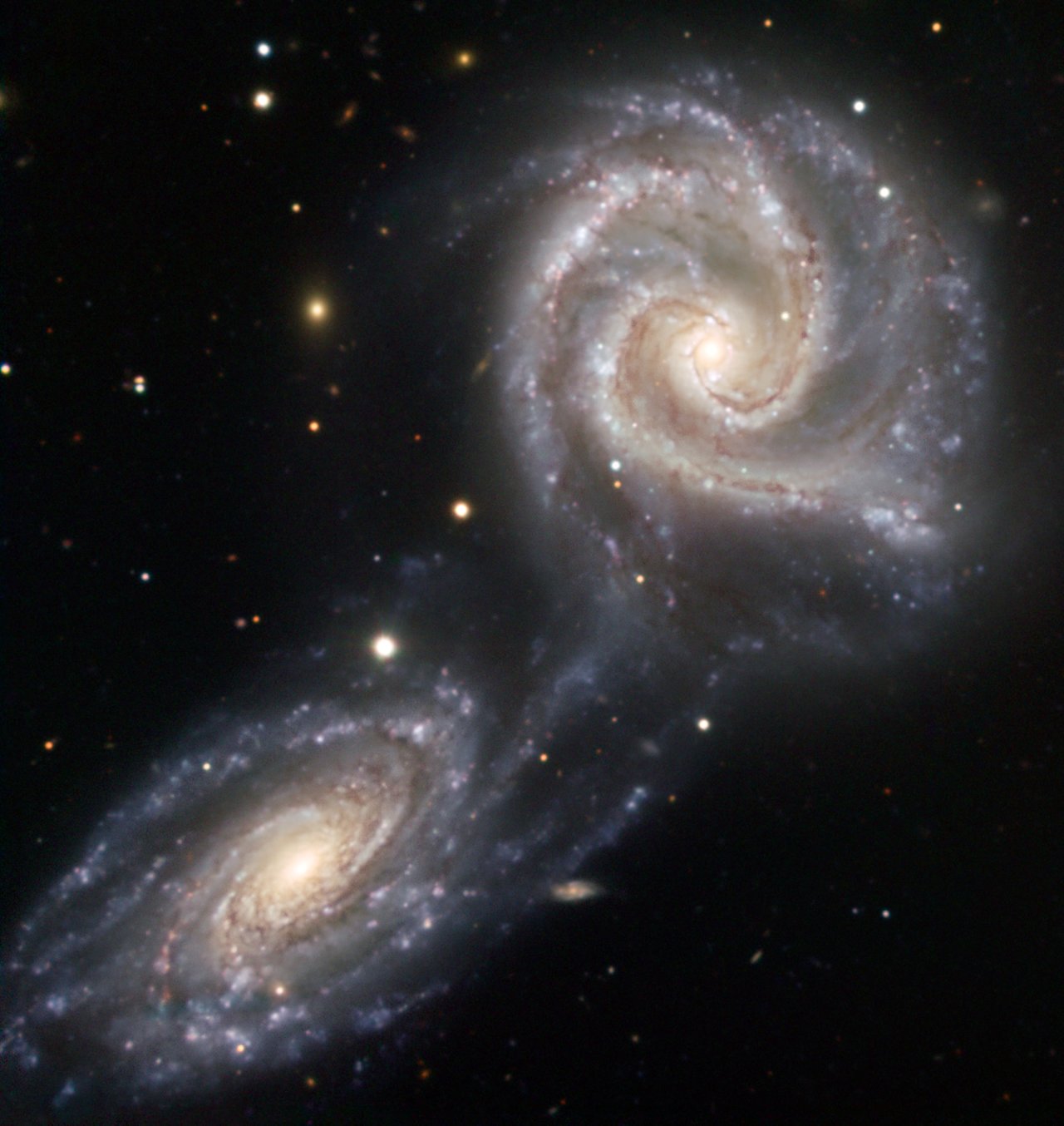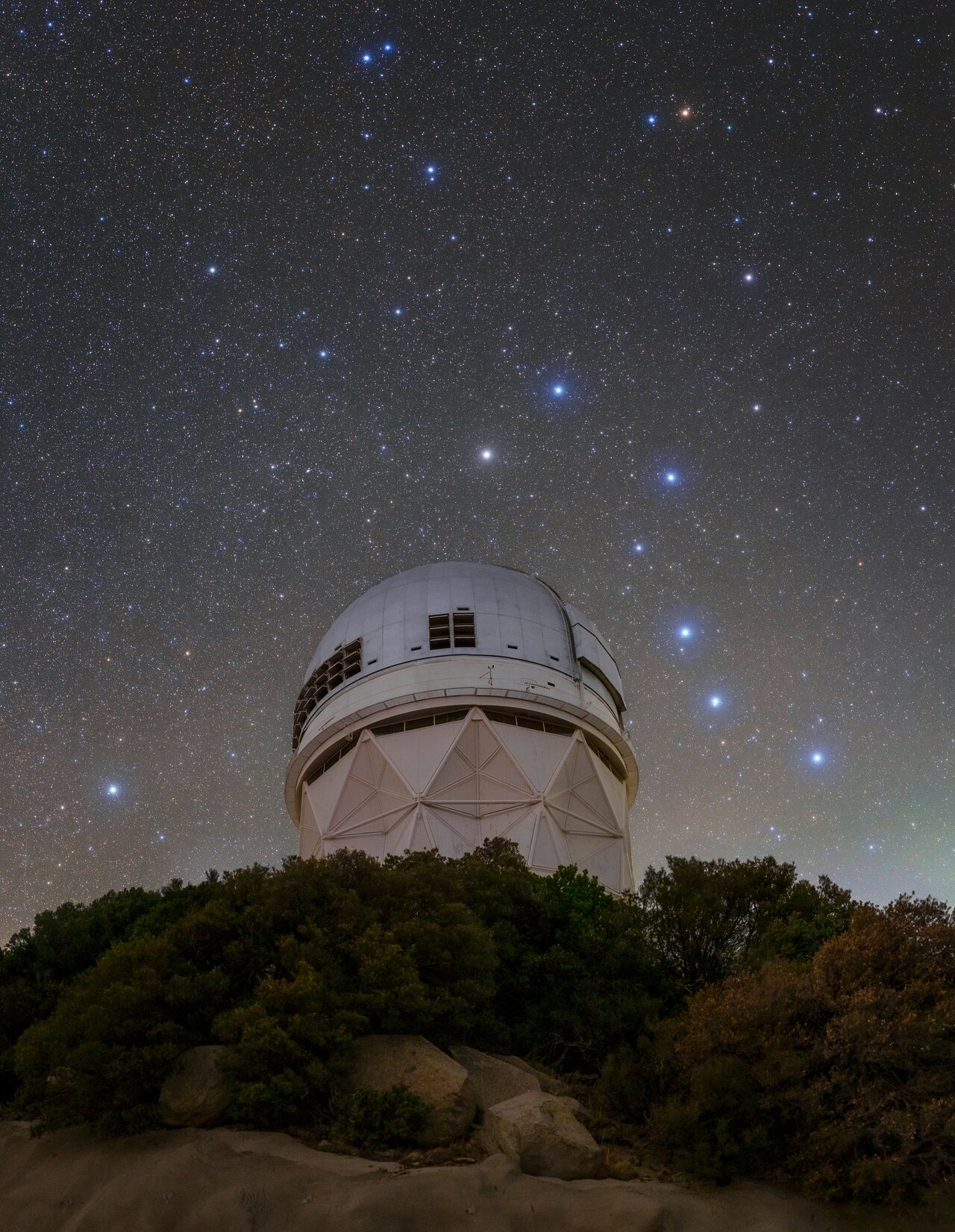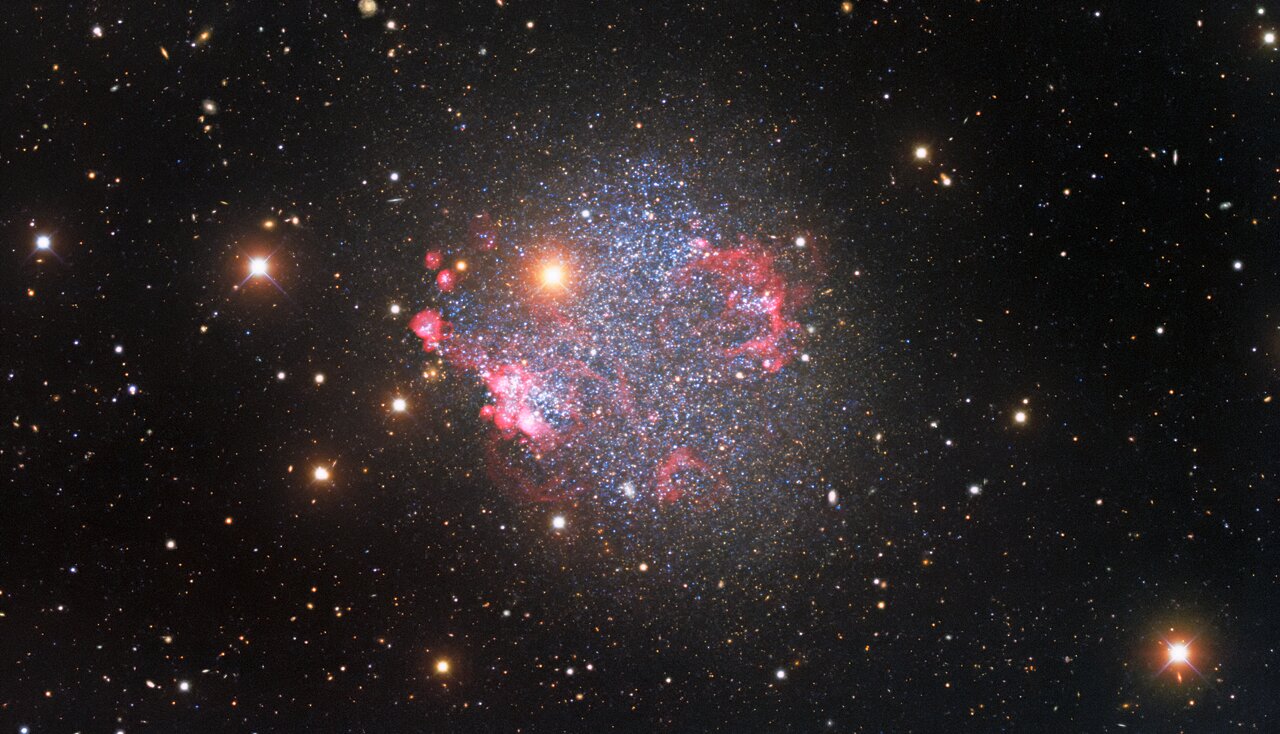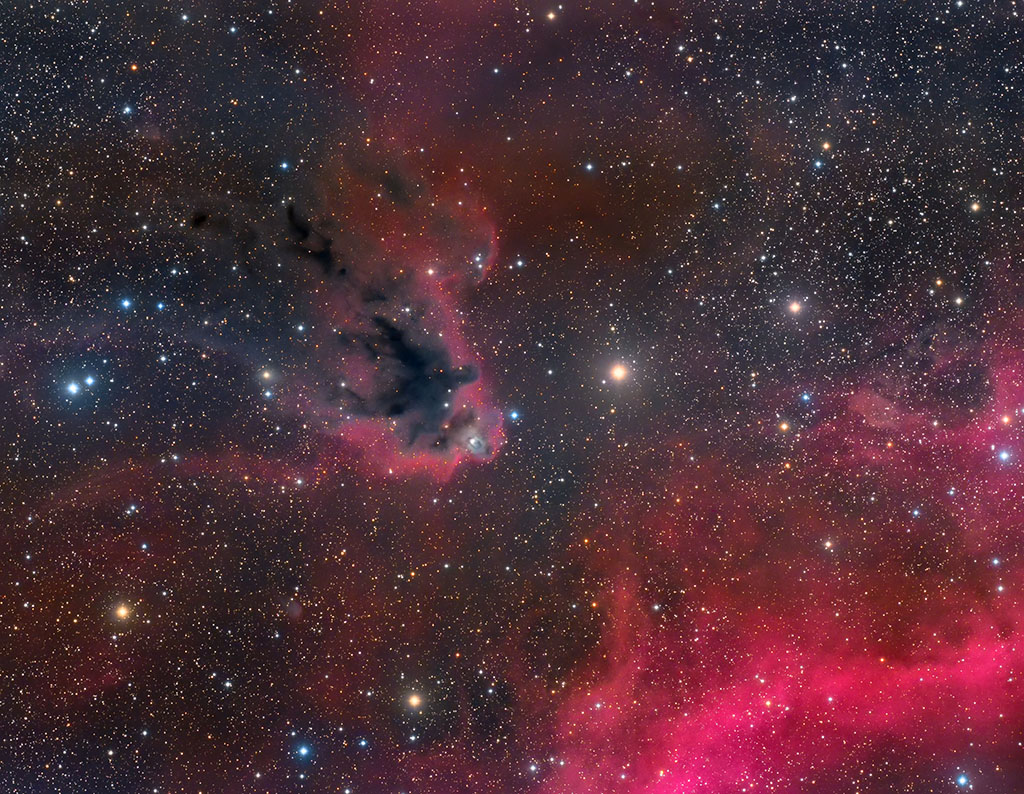Page 1 of 2
Found Images: 2023 June
Posted: Mon Jun 05, 2023 3:28 pm
by bystander
Have you seen a great image or video somewhere that you think would make a great APOD? Nominate it for APOD! Please post as much information here as you have about the image/video with a link to any source(s) for it you know of here, and the editors will take a look.
When posting the image itself, please do not post anything larger than a thumbnail here; please honor the copyright holder's copyright.
Please keep hotlinked images under 500K.
Thank you!
<< Previously
NOIRLab: Colorful Clouds over Cerro Pachón
Posted: Mon Jun 05, 2023 6:16 pm
by bystander
Colorful Clouds over Cerro Pachón
NOIRLab Image of the Week | 2023 May 31
A rainbow cloud creates a stunning curtain of colors just after sunrise in this image taken from
Cerro Pachón in Chile, home of one half of the International
Gemini Observatory, the
SOAR Telescope, and
Vera C. Rubin Observatory, all operated by NSF’s NOIRLab. The appearance of pastel pigmentation sweeping across the sky is possibly due to the phenomenon known as
cloud iridescence. Similar to the swirling colors on the surface of a bubble or oil spill, this optical effect occurs when sunlight passes through a particularly thin cloud that is composed of water droplets or ice crystals of uniform size. As the Sun’s rays encounter individual crystals, the light is both
diffracted and
scattered, revealing a gradient of the component wavelengths, or colors, that make up the Sun’s light.
Because of the smooth, wavy shape of the clouds in this image, they closely resemble a different class of iridescent clouds called
nacreous clouds, which are also produced by uniformly sized ice crystals diffracting sunlight. But unlike regular
iridescent clouds that form in the
troposphere and can be seen all over the world,
nacreous clouds form at a higher elevation, in the
stratosphere, and most often in frigid regions such as Antarctica, Alaska, and Scandinavia where the lower stratosphere cools below – 85° Celsius (–120° Fahrenheit).
ESO: Telescopes Inside a Washing Machine?
Posted: Mon Jun 05, 2023 6:30 pm
by bystander
Telescopes Inside a Washing Machine?
ESO Picture of the Week | BlackGEM | 2023 Jun 05
This Picture of the Week shows a long exposure image of the
BlackGEM telescopes, located at ESO’s
La Silla Observatory in Chile. The whitish star trails in the sky are an effect due to the Earth’s rotation on its axis around the southern
celestial pole, which gives the impression of the stars’ movement over the course of several hours. To the right hand side of the central telescope the Milky Way is visible, seen here as a particularly bright region, densely packed with streaks of starlight. As these streaks move in circles across the night sky, the viewer gets a sense of tumbling around inside a giant washing machine, as they peer out at the scene through the fisheye lens.
BlackGEM, which recently
started operating, is an array of three 0.65-metre optical telescopes, which can point at different regions of the sky, searching for some of the most dramatic events in the Universe like merging
neutron stars and
black holes. As these events unfold they send out ripples in spacetime, known as
gravitational waves, which can be picked up by observatories like
LIGO and
Virgo. BlackGEM can then pinpoint the light sources from the
afterglow of these events, allowing for more detailed follow-up observations of these cataclysmic collisions.
ESA: Under the Sea
Posted: Mon Jun 05, 2023 7:09 pm
by bystander
Under the Sea
ESA Hubble Picture of the Week | 2023 Jun 05
The jellyfish
galaxy JO206 trails across this image from the NASA/ESA Hubble Space Telescope, showcasing a colourful
star-forming disc surrounded by a pale, luminous cloud of dust. A handful of bright stars with criss-cross diffraction spikes stand out against an inky black backdrop at the bottom of the image. JO206 lies over 700 million light-years from Earth in the constellation
Aquarius, and this image of the galaxy is the sixth and final installment in a series of observations of jellyfish galaxies. Some of Hubble's other observations of these peculiar galaxies — which range from
grandiose to
ghostly — are available
here.
Jellyfish galaxies are so-called because of their resemblance to their aquatic namesakes. In this image, the disc of JO206 is trailed by long tendrils of bright
star formation that stretch towards the bottom right of this image, just as jellyfish trail tentacles behind them. The tendrils of jellyfish galaxies are formed by the interaction between galaxies and the intra-cluster medium, a tenuous superheated plasma that pervades galaxy clusters. As galaxies move through galaxy clusters they ram into the
intracluster medium, which strips gas from the galaxies and draws it into the long tendrils of star formation.
The tentacles of jellyfish galaxies give astronomers a unique opportunity to study star formation under extreme conditions, far from the influence of the main disc of the galaxy. Surprisingly, Hubble revealed that there are no striking differences between star formation in the discs of jellyfish galaxies and star formation in their tentacles, which suggests the environment of newly-formed stars has only a minor influence on their formation.
UV and Hα HST Observations of Six GASP Jellyfish Galaxies ~ Marco Gullieuszik
et al
HST Imaging of Star-Forming Clumps in Six Gasp Ram-Pressure Stripped Galaxies ~ Eric Giunchi
et al
viewtopic.php?p=331183#p331183
viewtopic.php?p=330675#p330675
viewtopic.php?p=330331#p330331
viewtopic.php?p=329922#p329922
viewtopic.php?p=329472#p329472
Re: Found Images: 2023 June
Posted: Mon Jun 05, 2023 10:17 pm
by starsurfer
Re: Found Images: 2023 June
Posted: Mon Jun 05, 2023 10:21 pm
by starsurfer
StDr 20
https://www.astrobin.com/3dwx7r/
Copyright: Marcel Drechsler/Xavier Strottner/Chilescope
The StDr catalogue can be accessed
here.
Re: Found Images: 2023 June
Posted: Mon Jun 05, 2023 10:28 pm
by starsurfer
Re: Found Images: 2023 June
Posted: Mon Jun 05, 2023 10:29 pm
by starsurfer
NGC 2442
https://www.chart32.de/index.php/component/k2/item/144
Copyright: CHART32
Processing: Volker Wendel
Re: Found Images: 2023 June
Posted: Mon Jun 05, 2023 10:33 pm
by starsurfer
G288.7-6.3
https://www.astrobin.com/7a26qp/
Copyright: Bray Falls
This supernova remnant might have a size of 2 degrees.
Re: Found Images: 2023 June
Posted: Mon Jun 05, 2023 10:42 pm
by starsurfer
G150.3+4.5 and MarSai Object 1
https://www.astrobin.com/khox60/
Copyright: Nicolas Martino/Yann Sainty/Xavier Strottner/Marcel Drechsler
The background emission nebulosity belongs to the emission nebula Du 71, which has a size of 3.5 degrees. Du 71 can be seen in the bottom left corner of
this Ha mosaic from the MDW Sky Survey.
Re: Found Images: 2023 June
Posted: Mon Jun 05, 2023 10:46 pm
by starsurfer
ESA: Webb Peers Behind Bars (NGC 5068)
Posted: Tue Jun 06, 2023 12:07 am
by bystander
Webb Peers Behind Bars
ESA Webb Picture of the Month | 2023 Jun 02
A delicate tracery of dust and bright star clusters threads across this image from the NASA/ESA/CSA James Webb Space Telescope. The bright tendrils of gas and stars belong to the
barred spiral galaxy NGC 5068, whose bright central bar is visible in the upper left of this image.
NGC 5068 lies around 17 million light-years from Earth in the constellation
Virgo.
This portrait of NGC 5068 is part of a campaign to create an astronomical treasure trove, a repository of observations of star formation in nearby galaxies. Previous gems from this collection can be seen
here and
here. These observations are particularly valuable to astronomers for two reasons. The first is because star formation underpins so many fields in astronomy, from the physics of the tenuous plasma that lies between stars to the evolution of entire
galaxies. By observing the formation of stars in nearby galaxies, astronomers hope to kick-start major scientific advances with some of the first available data from Webb. ...
This image is a composite of image data from two of Webb's instruments, MIRI and NIRCam.
NOIRLab: Celestial Landmarks of the Northern Sky
Posted: Wed Jun 07, 2023 7:21 pm
by bystander
Celestial Landmarks of the Northern Sky
NOIRLab Image of the Week | KPNO | 2023 Jun 07
The eighteen-story
Nicholas U. Mayall 4-meter Telescope is located at Kitt Peak National Observatory (
KPNO), a Program of NSF’s NOIRLab, and is seen here against the backdrop of two celestial landmarks of the northern hemisphere: The constellation
Ursa Major (the Great Bear), with its seven bright stars that make the
Big Dipper, on the right side of Mayall and the North Star
Polaris on the left.
The stars of the Big Dipper asterism are notable even on their own. The second star in the Big Dipper’s handle is
Mizar and together with its fainter companion star
Alcor they are known as the
Horse and Rider. Their pairing is a naked-eye double since they appear to observers to be right next to each other. Because of their close proximity, trying to resolve the pair with only the naked eye has been a traditional sight test in many countries. The stars
Merak (blue) and
Dubhe (white), that form the front of the Big Dipper’s cup, are often used for celestial navigation. By connecting the two with an imaginary line and extending it across the sky, the North Star Polaris can easily be located, seen here the brightest star to the far left of the Mayall telescope. Polaris’s stable position has made it useful for northern hemisphere navigation since the 5th century. ...
Re: Found Images: 2023 June
Posted: Thu Jun 08, 2023 10:25 pm
by starsurfer
Re: Found Images: 2023 June
Posted: Thu Jun 08, 2023 10:28 pm
by starsurfer
NGC 7094
https://www.astrobin.com/ll3zh3/
Copyright: Boris Chausov
Re: Found Images: 2023 June
Posted: Sat Jun 10, 2023 10:40 pm
by starsurfer
Sextans A
https://noirlab.edu/public/images/iotw2126a/
Copyright: KPNO/NOIRLab/NSF/AURA
Data obtained and processed by: P. Massey (Lowell Obs.), G. Jacoby, K. Olsen, & C. Smith (AURA/NSF)
Processing: T.A. Rector (University of Alaska Anchorage/NSF’s NOIRLab), M. Zamani (NSF’s NOIRLab) & D. de Martin (NSF’s NOIRLab)
Re: Found Images: 2023 June
Posted: Sat Jun 10, 2023 10:43 pm
by starsurfer
IC 4601
http://www.capella-observatory.com/Imag ... IC4601.htm
Copyright: Josef Pöpsel, Stefan Binnewies and Frank Sackenheim
Re: Found Images: 2023 June
Posted: Tue Jun 13, 2023 10:23 pm
by starsurfer
Re: Found Images: 2023 June
Posted: Tue Jun 13, 2023 10:24 pm
by starsurfer
LDN 1622
https://aipastroimaging.com/ldn1622/
Copyright: Álvaro Ibáñez Pérez
Re: Found Images: 2023 June
Posted: Tue Jun 13, 2023 10:26 pm
by starsurfer
Re: Found Images: 2023 June
Posted: Wed Jun 14, 2023 1:16 am
by barretosmed
THE TRIO OF GALAXIES OF THE CONSTELLATION OF LEO (M105, NGC 3384 AND NGC 3389)
The trio of galaxies form an image of a face, with NGC 3384 in the upper right corner, M105 (also called NGC 3379) in the upper left corner and below, forming the mouth, we have NGC 3389
BEST DETAILS:
https://www.astrobin.com/full/unjhvp/0/
EQUIPMENT:
Esprit 150mm triplet
zwo asi 6200mc
Mount CEM120
Frames 168X300"
LOCATION: Munhoz - MG - Brazil
DATES: From 03/18/2023 to 05/25/2023
PROCESSING AND CAPTURE:
Adobe Photoshop, ASTAP, SGP, PHD2 and PixInsight
Author: Fernando Oliveira de Menezes
Email:
Barretosmed@hotmail.com
(Organizing author of the book Amateur Astrophotography in Brazil)
https://clubedeautores.com.br/livro/ast ... lCopyright: Your name
ESO: What’s that coming over the hill? It’s ALMA!
Posted: Thu Jun 15, 2023 1:39 pm
by bystander
What’s that coming over the hill? It’s ALMA!
ESO Picture of the Week | ALMA | 2023 Jun 12
It might look like there’s not a lot going on in this Picture of the Week, but looks can be deceiving. Far off in the distance, huddled together like penguins in an Antarctic storm, sit the 66 high-precision antennas of the Atacama Large Millimeter/submillimeter Array (
ALMA). Operated by ESO together with international partners,
ALMA is designed to study the light emitted by the coldest objects in the Universe, such as vast cold clouds in interstellar space.
Stretching out either side of the antennas is the empty landscape of the
Chajnantor plateau. Sitting at 5,000 m above sea level in the Chilean Andes, this remote location is one of the driest places on Earth. It’s this dryness that makes it the perfect place for observing the signals from the cold Universe which would otherwise be heavily absorbed by water vapour in our atmosphere.
ALMA is what’s known as an
interferometer, meaning that its individual antennas work together, acting to form a more powerful telescope that can discern details smaller than what can be seen with the individual antennas. Depending on what observations are being carried out, the antennas are arranged in different configurations. The further away they are, the finer the details they can see; more compact configurations, on the other side, offer better sensitivity and are ideal when observing diffuse extended objects. Here the antennas are in one of the most compact configurations, but the distance between them can be as great as 16 kilometres!
ESA: A Dishevelled Irregular Galaxy (NGC 7292)
Posted: Thu Jun 15, 2023 1:53 pm
by bystander
A Dishevelled Irregular Galaxy
ESA Hubble Picture of the Week | 2023 Jun 12
The
galaxy NGC 7292 billows across this image from the NASA/ESA Hubble Space Telescope, accompanied by a handful of bright stars and the indistinct smudges of extremely distant galaxies in the background. It lies around 44 million light-years from Earth in the constellation
Pegasus.
This slightly dishevelled galaxy is
irregular, meaning that it lacks the distinct
spiral arms of galaxies like the
Whirlpool Galaxy or the smooth
elliptical shape of galaxies like
Messier 59. Unusually, its core is stretched out into a distinct bar, a feature seen in many spiral galaxies. Alongside its hazy shape, NGC 7292 is remarkably faint. As a result, astronomers classify NGC 7292 as a
low surface brightness galaxy, barely distinguishable against the backdrop of the night sky. Such galaxies are typically dominated by gas and dark matter rather than stars.
Astronomers directed Hubble to inspect NGC 7292 during an observational campaign studying the aftermath of Type II
supernovae. These colossal explosions happen when a massive star collapses and then violently rebounds in a catastrophic explosion that tears the star apart. Astronomers hope to learn more about the diversity of Type II supernovae they have observed by scrutinising the aftermath and remaining nearby stars of a large sample of historical
Type II supernovae.
NGC 7292’s supernova was observed in 1964 and accordingly given the identifier
SN 1964H. Studying the stellar neighbourhood of SN 1964H helps astronomers estimate the initial mass of the star that went supernova, and could uncover surviving stellar companions that once shared a system with the star that would become SN 1964H.
NOIRLab: Red Bloom above Cerro Tololo
Posted: Thu Jun 15, 2023 2:03 pm
by bystander
Red Bloom above Cerro Tololo
NOIRLab Image of the Week | CTIO | 2023 Jun 14
Below the southern skies, the telescopes of Cerro Tololo Inter-American Observatory (
CTIO), a Program of NSF’s NOIRLab, bask in the starlight of the brilliant Milky Way. Speckled with multi-colored stars, our home galaxy in this image stretches down into the city-lit horizon, just grazing past the
Víctor M. Blanco 4-meter Telescope (left) and
SMARTS 1.5-meter Telescope (right). The
Small and
Large Magellanic Clouds that accompany our home galaxy are seen to the left of the Blanco telescope. In between the telescopes blooms a deep shade of red that permeates through the tendrils of the
Milky Way. This is the
Gum Nebula, an
emission nebula that blazes with the light of gas ionized by its host stars. From our perspective it holds a bountiful number of cosmic objects, from
globular clusters, to the
Vela Pulsar, and even to an
11,000-year-old supernova remnant.
Re: Found Images: 2023 June
Posted: Fri Jun 16, 2023 10:10 pm
by starsurfer
NGC 5466
https://www.astrobin.com/c6ri0p/
Copyright: Rafael Schmall











